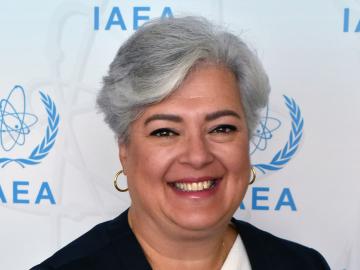
Filter News
Area of Research
- (-) Fusion and Fission (15)
- (-) National Security (25)
- Advanced Manufacturing (2)
- Biology and Environment (52)
- Biology and Soft Matter (1)
- Building Technologies (2)
- Clean Energy (49)
- Computational Biology (1)
- Computer Science (1)
- Electricity and Smart Grid (1)
- Functional Materials for Energy (2)
- Isotopes (3)
- Materials (43)
- Materials for Computing (6)
- Neutron Science (14)
- Renewable Energy (1)
- Supercomputing (39)
News Topics
- 3-D Printing/Advanced Manufacturing (1)
- Advanced Reactors (1)
- Artificial Intelligence (3)
- Big Data (2)
- Bioenergy (2)
- Biology (4)
- Biomedical (2)
- Biotechnology (1)
- Buildings (1)
- Chemical Sciences (2)
- Climate Change (4)
- Computer Science (8)
- Coronavirus (1)
- Cybersecurity (5)
- Decarbonization (2)
- Energy Storage (3)
- Environment (2)
- Exascale Computing (1)
- Fossil Energy (1)
- Frontier (1)
- Fusion (6)
- Grid (4)
- High-Performance Computing (1)
- ITER (2)
- Machine Learning (4)
- Materials (1)
- Materials Science (2)
- National Security (13)
- Neutron Science (2)
- Nuclear Energy (8)
- Partnerships (2)
- Physics (2)
- Security (4)
- Simulation (1)
- Space Exploration (1)
- Summit (1)
- Sustainable Energy (4)
- Transportation (1)
Media Contacts

Though Scott Stewart recently received an Early Career Award from the Institute of Nuclear Material Management, he is regarded as a seasoned professional in the nuclear field with over 10 years of experience.

Researchers in the geothermal energy industry are joining forces with fusion experts at ORNL to repurpose gyrotron technology, a tool used in fusion. Gyrotrons produce high-powered microwaves to heat up fusion plasmas.

Countries around the world have unique languages, cultures, food, entertainment and governments. Yet, more than 170 countries are finding common ground in an unlikely field: nuclear material and science.

Oak Ridge National Laboratory physicist Elizabeth “Libby” Johnson (1921-1996), one of the world’s first nuclear reactor operators, standardized the field of criticality safety with peers from ORNL and Los Alamos National Laboratory.

When Matt McCarthy saw an opportunity for a young career scientist to influence public policy, he eagerly raised his hand.

Cameras see the world differently than humans. Resolution, equipment, lighting, distance and atmospheric conditions can impact how a person interprets objects on a photo.

When the COVID-19 pandemic stunned the world in 2020, researchers at ORNL wondered how they could extend their support and help

Though Nell Barber wasn’t sure what her future held after graduating with a bachelor’s degree in psychology, she now uses her interest in human behavior to design systems that leverage machine learning algorithms to identify faces in a crowd.

Steven Arndt, distinguished R&D staff member in the Nuclear Energy and Fuel Cycle Division at ORNL, began a one-year term on June 16 as the 68th President of the American Nuclear Society.

In front of family and friends, Lt. Col. Jessica Critcher and Maj. Micah McCracken gave their final report on their eye-opening year as ORNL military fellows.


